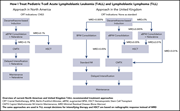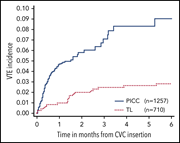Issue Archive
Table of Contents
BLOOD COMMENTARIES
HOW I TREAT
How I treat newly diagnosed T-cell acute lymphoblastic leukemia and T-cell lymphoblastic lymphoma in children
Clinical Trials & Observations
Historically, these aggressive T-cell malignancies have carried poor prognoses. Teachey and O’Connor use 3 cases to illustrate how excellent outcomes can now be expected for the majority of children using the same regimens for both diseases. They tackle issues around indications for allogeneic stem cell transplantation and cranial radiation, the use of nelarabine, and whether to use different regimens for early T-cell precursor acute lympoblastic leukemia.
IMMUNOBIOLOGY AND IMMUNOTHERAPY
Myeloid cell–targeted miR-146a mimic inhibits NF-κB–driven inflammation and leukemia progression in vivo
Dual targeting of both the cell of interest and the molecular driver is a holy grail of precision therapeutics. In this preclinical proof-of-principle article, Su et al demonstrate that NF-κB–driven cytokine release syndrome and preclinical models of myeloid malignancy can be achieved using a synthetic microRNA mimic conjugated to a scavenger receptor agonist.
LYMPHOID NEOPLASIA
Localized- and advanced-stage follicular lymphomas differ in their gene expression profiles
About 20% of follicular lymphomas present as localized-stage disease. Intriguingly, only half carry t(14;18). Staiger and colleagues have identified distinct gene expression signatures that distinguish localized-stage from advanced-stage disease, providing insights into the biological difference between these subgroups.
MYELOID NEOPLASIA
HDAC11 deficiency disrupts oncogene-induced hematopoiesis in myeloproliferative neoplasms
In this preclinical exploration, Yue and colleagues investigated the specific roles of HDAC6 and HDAC11 in JAK/STAT–driven myeloproliferation. They identify HDAC11 as a potential target molecule that can regulate the phenotype of myeloproliferative neoplasms while also being dispensable for normal hematopoiesis.
RED CELLS, IRON, AND ERYTHROPOIESIS
Wdr26 regulates nuclear condensation in developing erythroblasts
Wdr26, a gene upregulated during terminal erythropoiesis, encodes a core subunit of the glucose-induced degradation-deficient ubiquitin ligase complex. Zhen et al reveal its essential role in a pathway for nuclear opening formation, nuclear condensation, and enucleation during terminal erythropoiesis.
THROMBOSIS AND HEMOSTASIS
Peripherally inserted central catheters lead to a high risk of venous thromboembolism in children
CME
Clinical Trials & Observations
The use of peripherally inserted central catheters (PICCs) in children has increased due to ease of placement compared to tunneled lines and the thought that PICCs have fewer associated adverse events. This month’s CME article reports on the largest prospective observational study of long-term central venous catheter–related complications in children to date, in which this dogma is overturned. The research provides important information for decision-making about when to use central catheters and which type to choose.
LETTER TO BLOOD
Romiplostim in patients undergoing hematopoietic stem cell transplantation: results of a phase 1/2 multicenter trial
Clinical Trials & Observations
Persisting severe thrombocytopenia more than 6 weeks after allogeneic stem cell transplantation is a common problem associated with adverse prognosis. Peffault de Latour et al report the results of the first trial of the thrombopoietin mimetic, romiplostim, in this setting, demonstrating recovery of platelet counts in 18 of 24 patients.
BLOOD WORK
CONTINUING MEDICAL EDUCATION (CME) QUESTIONS
-
Cover Image
Cover Image
![issue cover]()
Giemsa staining of red blood cells from wdr26b-knockout zebrafish. Fish red cells contain highly condensed nuclei. Loss of wdr26b in zebrafish impairs erythroblast nuclear condensation and leads to larger nuclei in circulating red cells. See the article by Zhen et al on page 208.
- PDF Icon Front MatterFront Matter
- PDF Icon Table of ContentsTable of Contents
- PDF Icon Back MatterBack Matter
- PDF Icon Editorial BoardEditorial Board
Advertisement intended for health care professionals
Email alerts
Advertisement intended for health care professionals









MicroRNA immunomodulating therapeutics